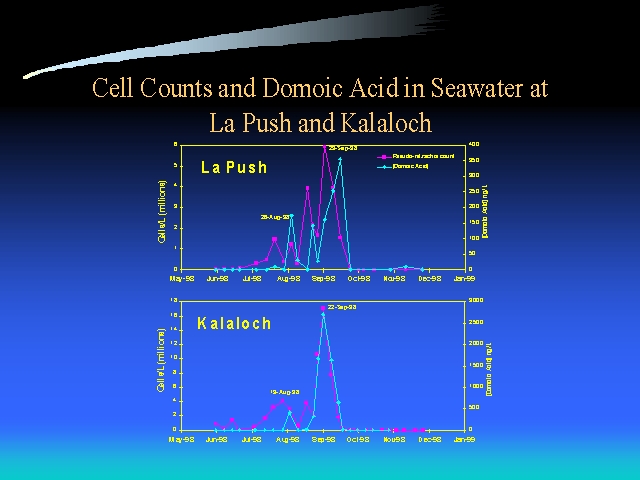Slide 9 of 17
Notes:
9. CELL COUNTS AND DOMOIC ACID IN SEAWATER AT LA PUSH AND KALALOCH
-Same cell count data but plots on different scales�-General agreement between Toxin and Cell counts�-When Cell counts crashed, toxin crashed�-Explanations for Discrepancies� -Cells growing but not producing toxin� -Cells not growing but producing toxin� -Species succession� -P. pseudodelicatissima at Kalaloch� -non-toxin producing to P. Pseudodelicatissima to non-toxin producing
MESSAGE: TOXIN DETECTED WHEN TOXIN PRODUCING CELLS ARE PRESENT
Using the same cell count data shown earlier, we have plotted here the concentration of domoic acid measured in seawater for each site. We see general agreement between the presence of Pseudo-nitzschia and the presence of toxin in seawater. When Pseudo-nitzschia crashed, the toxin concentrations in seawater also crashed.
Some plausible explanations for the phase shift seen at La Push: the cells are growing but not producing toxin which would give us high cell counts but relatively low toxin concentrations; the cells are not growing but producing large quantities of toxin which could give relatively low cell counts but high toxin concentrations; or there is species succession going on.
P. pseudodelicatissima Implicated. At the Kalaloch site, prior to the detection of high levels of toxin in seawater, the population of total pseudo-nitzschia contained a relatively low percentage of P. pseudodelicatissima; however, at the time we detected high levels of toxin in the seawater the population was made up almost exclusively of P. pseudodelicatissima, in addition, after the toxin peaks other species of Pseudo-nitzschia began to dominate the population.

















